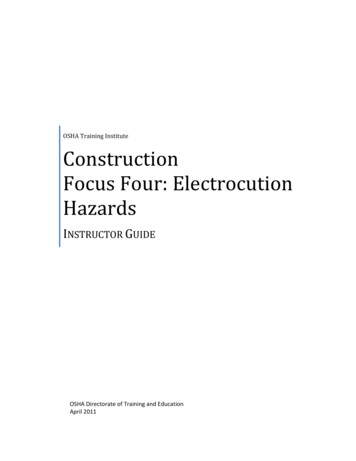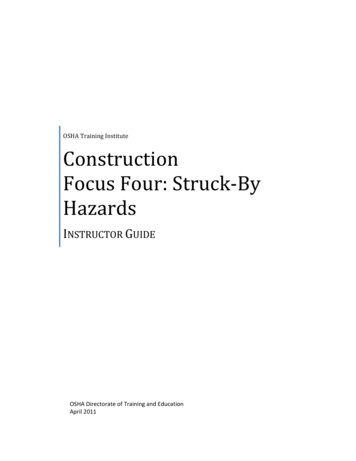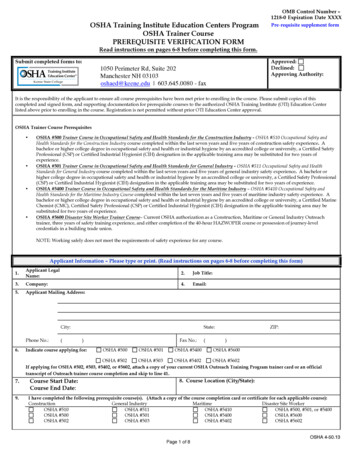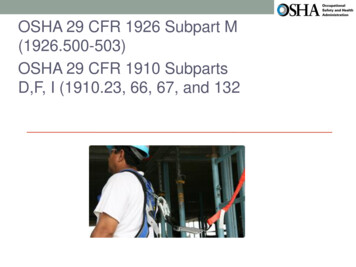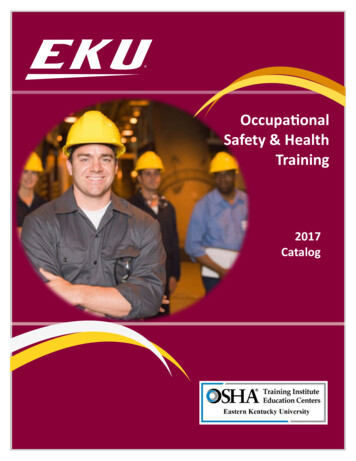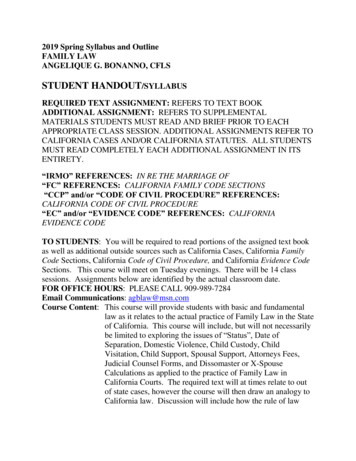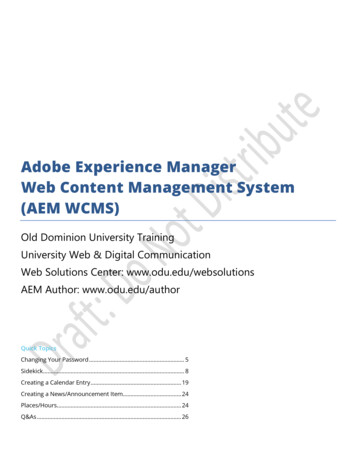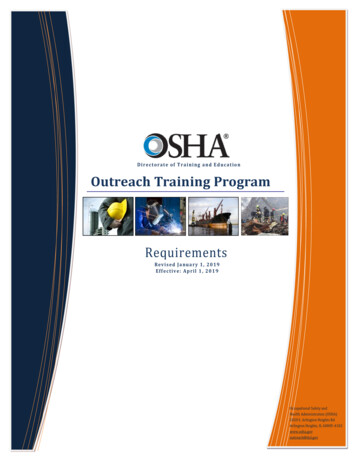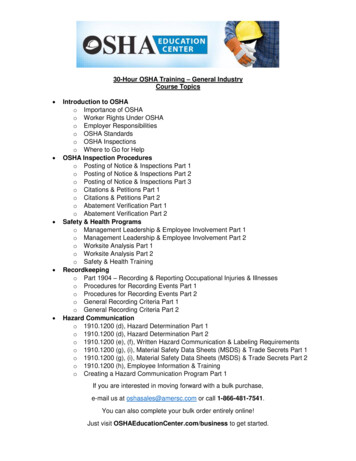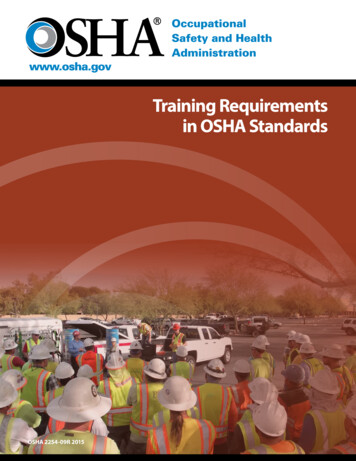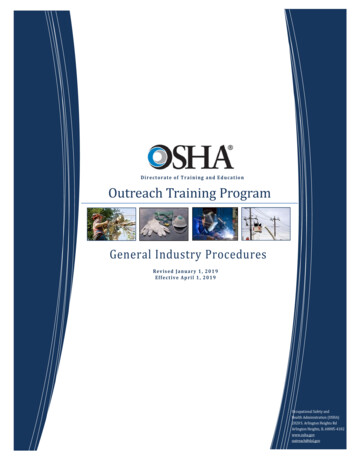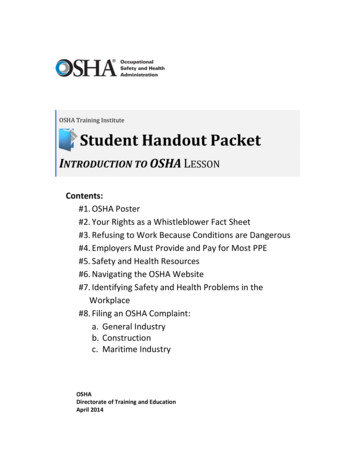
Transcription
OSHA Training InstituteStudent Handout PacketINTRODUCTION TO OSHA LESSONContents:#1. OSHA Poster#2. Your Rights as a Whistleblower Fact Sheet#3. Refusing to Work Because Conditions are Dangerous#4. Employers Must Provide and Pay for Most PPE#5. Safety and Health Resources#6. Navigating the OSHA Website#7. Identifying Safety and Health Problems in theWorkplace#8. Filing an OSHA Complaint:a. General Industryb. Constructionc. Maritime IndustryOSHADirectorate of Training and EducationApril 2014
Intentional blank page to accommodate 2-sided printing.
Intentional blank page to accommodate 2-sided printing.
Handout #2FactSheetYour Rights as a WhistleblowerYou may file a complaint with OSHA if your employer retaliates against you by taking unfavorable personnel action because you engaged in protected activity relating to workplacesafety and health, commercial motor carrier safety, pipeline safety, air carrier safety,nuclear safety, the environment, asbestos in schools, corporate fraud, SEC rules orregulations, railroad carrier safety or security, or public transportation agency safetyor security.Whistleblower Laws Enforced by OSHA Denying benefitsEach law requires that complaints be filed within acertain number of days after the alleged retaliation. IntimidationYou may file complaints by telephone or in writingunder the: Reducing pay or hours Failing to hire or rehire Reassignment affecting promotion prospects Occupational Safety and Health Act (30 days)Filing a Complaint Surface Transportation Assistance Act(180 days)If you believe that your employer retaliated againstyou because you exercised your legal rights as anemployee, contact your local OSHA office as soon aspossible, because you must file your complaint withinthe legal time limits. OSHA conducts an in-depthinterview with each complainant to determinewhether to conduct an investigation. For more information, call your closest OSHA Regional Office: Asbestos Hazard Emergency Response Act(90 days) International Safe Container Act (60 days) Federal Rail Safety Act (180 days) National Transit Systems Security Act (180 days)Under the following laws, complaints must be filed inwriting: Boston Clean Air Act (30 days)(617) 565-9860 New York(212) 337-2378 Philadelphia(215) 861-4900 Comprehensive Environmental Response,Compensation and Liability Act (30 days) Atlanta(404) 562-2300(312) 353-2220 Energy Reorganization Act (180 days) Chicago Federal Water Pollution Control Act (30 days) Dallas(972) 850-4145 Pipeline Safety Improvement Act (180 days) Kansas City(816) 283-8745 Safe Drinking Water Act (30 days) Denver(720) 264-6550 Sarbanes-Oxley Act (90 days) San Francisco(415) 625-2547 Solid Waste Disposal Act (30 days) Seattle(206) 553-5930 Toxic Substances Control Act (30 days)Addresses, fax numbers and other contact information for these offices can be found on OSHA’s website,www.osha.gov, and in local directories. Some complaints must be filed in writing and some may be filedverbally (call your local OSHA office for assistance).Written complaints may be filed by mail (we recommend certified mail), fax, or hand-delivered duringbusiness hours. The date postmarked, faxed or handdelivered is considered the date filed. Wendell H. Ford Aviation Investment and ReformAct for the 21st Century (90 days)Unfavorable Personnel ActionsYour employer may be found to have retaliatedagainst you if your protected activity was a contributing or motivating factor in its decision to take unfavorable personnel action against you.Such actions may include: Firing or laying offIf retaliation for protected activity relating to occupational safety and health issues takes place in a statethat operates an OSHA-approved state plan, the complaint should be filed with the state agency, althoughpersons in those states may file with Federal OSHA atthe same time. Although the Occupational Safety and Blacklisting Demoting Denying overtime or promotion Disciplining1
Handout #2Health Act covers only private sector employees, stateplans also cover state and local government employees. For details, see http://www.osha.gov/fso/osp/index.html.How OSHA Determines Whether RetaliationTook PlaceThe investigation must reveal that: The employee engaged in protected activity; The employer knew about the protected activity; The employer took an adverse action; and The protected activity was the motivating factor (orunder some laws, a contributing factor) in the decision to take the adverse action against the employee.If the evidence supports the employee’s allegationand a settlement cannot be reached, OSHA will issuean order requiring the employer to reinstate theemployee, pay back wages, restore benefits, andother possible remedies to make the employee whole.Limited Protections for EmployeesWho Refuse to WorkYou have a limited right under the OSH Act to refuseto do a job because conditions are hazardous. Youmay do so under the OSH Act only when (1) youbelieve that you face death or serious injury (and thesituation is so clearly hazardous that any reasonableperson would believe the same thing); (2) you havetried to get your employer to correct the condition,and there is no other way to do the job safely; and (3)the situation is so urgent that you do not have time toeliminate the hazard through regulatory channelssuch as calling OSHA.Regardless of the unsafe condition, you are not protected if you simply walk off the job. For details, seehttp://www.osha.gov/as/opa/worker/refuse.html. OSHAcannot enforce union contracts or state laws that giveemployees the right to refuse to work.Whistleblower Protections inthe Transportation Industryviolations of Department of Transportation (DOT)motor carrier safety standards or regulations, or refusing to operate a vehicle because of such violations orbecause they have a reasonable apprehension ofdeath or serious injury.Similarly, employees of air carriers, their contractorsor subcontractors who raise safety concerns or reportviolations of FAA rules and regulations are protectedfrom retaliation, as are employees of owners andoperators of pipelines, their contractors and subcontractors who report violations of pipeline safety rulesand regulations. Employees involved in internationalshipping who report unsafe shipping containers arealso protected. In addition, employees of railroad carriers or public transportation agencies, their contractors or subcontractors who report safety or securityconditions or violations of federal rules and regulations relating to railroad or public transportation safety or security are protected from retaliation.Whistleblower Protections forVoicing Environmental ConcernsA number of laws protect employees who report violations of environmental laws related to drinkingwater and water pollution, toxic substances, solidwaste disposal, air quality and air pollution, asbestosin schools, and hazardous waste disposal sites. TheEnergy Reorganization Act protects employees whoraise safety concerns in the nuclear power industryand in nuclear medicine.Whistleblower Protections When ReportingCorporate FraudEmployees who work for publicly traded companiesor companies required to file certain reports with theSecurities and Exchange Commission are protectedfrom retaliation for reporting alleged mail, wire, orbank fraud; violations of rules or regulations of theSEC, or federal laws relating to fraud against shareholders.More InformationEmployees whose jobs directly affect commercialmotor vehicle safety are protected from retaliation bytheir employers for refusing to violate or for reportingTo obtain more information on whistleblower laws,go to www.osha.gov, and click on the link for“Whistleblower Protection.”This is one in a series of informational fact sheets highlighting OSHA programs, policies orstandards. It does not impose any new compliance requirements. For a comprehensive list ofcompliance requirements of OSHA standards or regulations, refer to Title 29 of the Code of FederalRegulations. This information will be made available to sensory impaired individuals upon request.The voice phone is (202) 693-1999; teletypewriter (TTY) number: (877) 889-5627.For more complete information:U.S. Department of Laborwww.osha.gov321-OSHA2(800)
HANDOUT #3Refusing to Work because Conditions are DangerousWorkers have the right to refuse to do a job if they believe in good faith that they areexposed to an imminent danger. "Good faith" means that even if an imminent dangeris not found to exist, the worker had reasonable grounds to believe that it did exist.The United States Supreme Court, in the Whirlpool case, issued the landmark rulingwhich more clearly defined a worker's right to refuse work where an employee hasreasonable apprehension that death or serious injury or illness might occur as aresult of performing the work. However, as a general rule, you do not have theright to walk off the job because of unsafe conditions.REFUSING WORK IS PROTECTED IF:Your right to refuse to do a task isprotected if ALL of the followingconditions are met: Where possible, you have askedthe employer to eliminate thedanger, and the employer failed todo so; and You refused to work in "goodfaith." This means that you mustgenuinely believe that animminent danger exists. Yourrefusal cannot be a disguisedattempt to harass your employeror disrupt business; and A reasonable person would agreethat there is a real danger ofdeath or serious injury; and There isn't enough time, due tothe urgency of the hazard, to getit corrected through regularenforcement channels, such asrequesting an OSHA inspection.CONDITIONS ARE MET, NEXT STEPS:When all of these conditions are met,you take the following steps: Ask your employer to correct thehazard; Ask your employer for other work; Tell your employer that you won'tperform the work unless and untilthe hazard is corrected; and Remain at the worksite untilordered to leave by youremployer.The table below offers a few “IF/THEN” scenarios to follow.IFTHENYou believe working conditions are unsafeor unhealthful.Your employer does not correct the hazardor disagrees with you about the extent ofthe hazard.Call your employer's attention to theproblem.You may file a complaint with OSHA.Your employer discriminates against youfor refusing to perform the dangerouswork.Contact OSHA immediately.Source: http://www.osha.gov/as/opa/worker/refuse.html
Intentional blank page to accommodate 2-sided printing.
HANDOUT #4Employers Must Provide and Pay for Most PPEPersonal Protective Equipment (PPE)The Occupational Safety and Health Administration (OSHA) requires that employers protect youfrom workplace hazards that can cause injury or illness. Controlling a hazard at its source is thebest way to protect workers. However, when engineering, work practice and administrativecontrols are not feasible or do not provide sufficient protection, employers must provide personalprotective equipment (PPE) to you and ensure its use.PPE is equipment worn to minimize exposure to a variety of hazards. Examples include itemssuch as gloves, foot and eye protection, protective hearing protection (earplugs, muffs), hard hatsand respirators.Employer Obligations Performing a "hazard assessment" of theworkplace to identify and control physicaland health hazards. Identifying and providing appropriate PPEfor employees. Training employees in the use and care ofthe PPE. Maintaining PPE, including replacing wornor damaged PPE. Periodically reviewing, updating andevaluating the effectiveness of the PPEprogram.Workers should: Properly wear PPE Attend training sessions on PPE Care for, clean and maintain PPE, an Inform a supervisor of the need to repairor replace PPE.Employers Must Pay for Personal Protective Equipment (PPE)On May 15, 2008, a new OSHA rule about employer payment for PPE went into effect. With fewexceptions, OSHA now requires employers to pay for personal protective equipment used tocomply with OSHA standards. The final rule does not create new requirements regarding whatPPE employers must provide.The standard makes clear that employers cannot require workers to providetheir own PPE and the worker’s use of PPE they already own must becompletely voluntary. Even when a worker provides his or her own PPE, theemployer must ensure that the equipment is adequate to protect the workerfrom hazards at the workplace.Examples of PPE that Employers Must Pay for Include: Metatarsal foot protectionRubber boots with steel toesNon-prescription eye protectionPrescription eyewear inserts/lenses forfull face respiratorsGoggles and face shields 1Fire fighting PPE (helmet, gloves, boots,proximity suits, full gear)Hard hatsHearing protectionWelding PPE
HANDOUT #4Employers Must Provide and Pay for Most PPEPayment Exceptions under the OSHA RuleEmployers are not required to pay for some PPE in certain circumstances: Non-specialty safety-toe protective footwear (including steel-toe shoes or boots) and nonspecialty prescription safety eyewear provided that the employer permits such items to be wornoff the job site. (OSHA based this decision on the fact that this type of equipment is verypersonal, is often used outside the workplace, and that it is taken by workers from jobsite tojobsite and employer to employer.) Everyday clothing, such as long-sleeve shirts, long pants, street shoes, and normal workboots. Ordinary clothing, skin creams, or other items, used solely for protection from weather,such as winter coats, jackets, gloves, parkas, rubber boots, hats, raincoats, ordinarysunglasses, and sunscreen Items such as hair nets and gloves worn by food workers for consumer safety. Lifting belts because their value in protecting the back is questionable. When the employee has lost or intentionally damaged the PPE and it must be replaced.OSHA Standards that ApplyOSHA Construction PPE Standards 1926.28: Personal protective equipment 1926.95: Criteria for personal protectiveequipment 1926.96: Occupational foot protection 1926.100: Head protection 1926.101: Hearing protection 1926.102: Eye and face protection 1926.103: Respiratory protectionOSHA General Industry PPE Standards 1910.132: General requirements andpayment 1910.133: Eye and face protection 1910.134: Respiratory protection 1910.135: Head protection 1910.136: Foot protection 1910.137: Electrical protective devices 1910.138: Hand protectionThere are also PPE requirements in shipyards and marine terminals and many standards onspecific hazards, such as 1910.1030: Bloodborne pathogens and 1910.146: Permit-requiredconfined spaces.OSHA standards are online at www.osha.gov.Sources: Employers Must Provide and Pay for PPE, New Jersey Work Environment Council(WEC) Fact Sheet OSHA Standards, 1910.132(h) and 1926.95(d) Employer Payment for Personal Protective Equipment Final Rule, Federal Register:November 15, 2007 (Volume 72, Number 220)2
HANDOUT #5Safety & Health ResourcesGovernment ResourcesOSHA: http://www.osha.gov/ Contactthe OSHA Office nearest you or contactthe toll free number:1-800-321-OSHA (6742)NIOSH: http://www.cdc.gov/niosh/Phon e NIOSH at1-800-CDC-INFO (1-800-232-4636)or Email at: cdcinfo@cdc.govNIOSH is a part of the Centers for DiseaseControl and Prevention(http://www.cdc.gov/).CDC has extensive information onhealth and safety topics.COSH GROUPSCOSH groups are private, non-profit coalitionsof labor unions, health and technicalprofessionals, and others interested inpromoting and advocating for worker health andsafety. If you don’t see a COSH group in yourarea, check the NATIONAL COSH website forlocal COSH groups.NATIONAL COUNCIL FOR OCCUPATIONALSAFETY & HEALTH National COSH is a federationof local and statewide "COSH" groups:http://www.coshnetwork.org/CACOSH – Chicago Area Committee onOccupational Safety and Health:http://www.cacosh.org/UniversitiesCORNELL UNIVERSITYSchool of Industrial and Labor MASSCOSH –Massachusetts Coalition onOccupational Safety and Health:http://www.masscosh.org/LABOR OCCUPATIONAL HEALTHPROGRAM, University of California atBerkeley: http://www.lohp.org/NATIONAL LABOR COLLEGE, GeorgeMeany Center: http://www.nlc.edu/UCLA, Labor Occupational Safety andHealth (UCLA-LOSH):http://www.losh.ucla.edu/NYCOSH – New York Committee forOccupational Safety and Health:http://www.nycosh.org/PHILAPOSH – Philadelphia Area Project forOccupational Safety and Health:http://www.philaposh.org/Prevention (http://www.cdc.gov/).UnionsThe following is a sample list of unions with links to useful health and safety information.AFL-CIO: http://www.aflcio.org/Issues/JobSafetyAFSCME: http://www.afscme.org/issues/73.cfmeLCOSH – The Electronic Library of Construction Safety and Health is a collection of informationon construction safety and health developed by CPWR – Center for Construction Research andTraining, with funding by NIOSH: http://www.elcosh.org/SEIU (Service Employees International Union) Health and Safety d-health.phpUAW Health and Safety Department: http://www.uaw.org/healthsafety
Intentional blank page to accommodate 2-sided printing.
HANDOUT #6Navigating the OSHA Websitehttp://www.osha.govThe elements of this valuable source of occupational safety and health information are featured:Graphic slideshow of OSHA highlights.Graphics are linked to the respective website.Links to the most current OSHA news andinformation.Recent incidents, as well as weekly summaries are posted. Regulations/Standards Enforcement Laws & Rulemaking Offices S&H Topics Training How to File a Complaint MORE Videos Data & Statistics Other Resources MORE
Intentional blank page to accommodate 2-sided printing.
HANDOUT #7Identifying Safety and Health Problems in the WorkplaceIdentifying health and safety problems can be as easy as answering basic questions. Todetermine if there are health and safety problems that need to be addressed in yourworkplace, use these questions: Do you or your co‐workers have injuries or health complaints? If so, what types? Who has been hurt or is having symptoms? When do you or your co‐workers feel these symptoms? Where in the workplace are safety or health problems occurring? What are the conditions that are causing problems?The following “Caution Health Hazards” and “Caution Safety Hazards” tables provide more information.CAUTION: Health HazardsCommon types of health hazards in the workplace are: Chemical (asbestos, solvents, chlorine) Biological (tuberculosis, HIV, hepatitis, molds) Physical (noise, heat and cold, radiation, vibration) Ergonomics or Repetitive Strain Injuries (carpal tunnel syndrome, back injuries) Psychological (stress)How health hazards enter your body: Breathing (inhalation) Swallowing (ingestion) Skin (absorption) Cuts (injection)Harm caused by health hazards depends on: Strength, or potency, of the agent. Amount of the agent that is present. How long you are exposed to the agent. Part of your body that is exposed.Types of health effects: Acute: the effect shows up right away. Chronic: problems show up after a long period of exposure and/or long after theexposure ends. Local: only the part of the body that was exposed is affected. Systemic: an agent enters the body and affects other parts of the body.Cancer Cancer is a term for many diseases in different parts of the body. Carcinogens are agents that cause cancer. There is no totally safe level of exposure to something that causes cancer. Cancer from a workplace exposure may develop 10, 20 or more years after exposure.Sensitization You may become allergic or sensitive to some agents you work with. Sensitization candevelop over time. For example, a health care worker may develop a serious allergic reaction to latexused in gloves.Reproductive effects Both men and women can be affected by reproductive hazards at work. Reproductive hazards cause
“Whistleblower Protection.” This is one in a series of informational fact sheets highlighting OSHA programs, policies or standards. It does not impose any new compliance requirements. For a comprehensive list of compliance requirements of OSHA standards or regulatio
